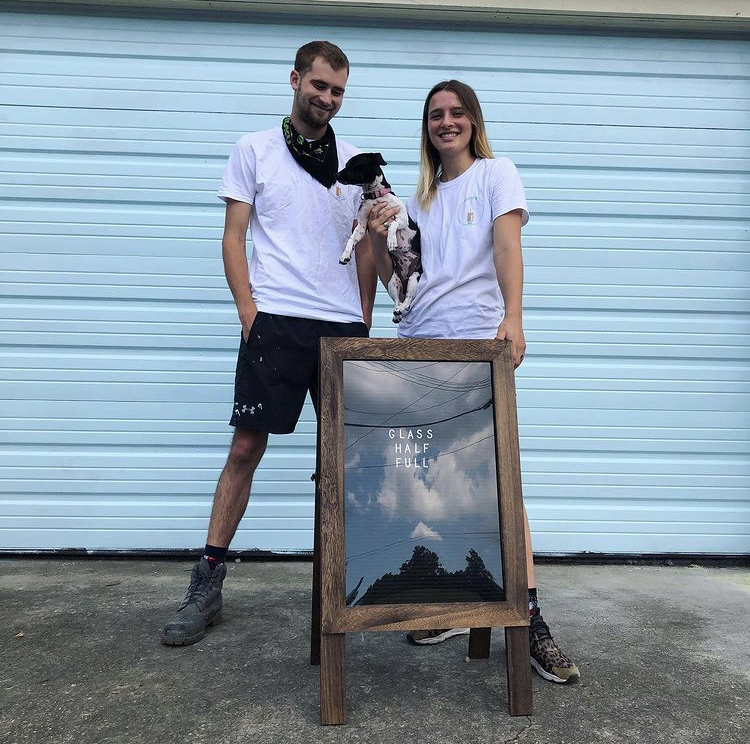Amidst a lack of recycling options plaguing New Orleans, two former Tulane students have created a grassroots glass recycling initiative to become a mainstay for the city. Founders Franziska Trautmann and Max Steitz launched Glass Half Full out of their backyards in early 2020, right before the global pandemic. Since then, the project has grown into a full-blown operation turning glass waste into beach-sand and glass cullet to be utilized in natural disaster relief and coastal reconstruction and preservation. Glass Half Full has created sustainable solutions for New Orleans, whose recycling program does not include glass, while providing an example for grassroots recycling and sustainability efforts nationwide.

Founders Max Steitz and Franziska Trautmann at the Glass Half Full facility with mascot Miss Tchoupitoulas.
Glass Half Full originated as a local project for seniors Franziska and Max, who sought to create a glass recycling system for themselves and their friends. After realizing the overwhelming need to cater to the greater New Orleans community, the two expanded the project from their backyard to fully operational processing plants, first on Joliet Street and then in New Orleans East. The duo has grown into a larger team of staff, volunteers, and advisors, all dedicated to the cause. Founder and Co-Director Max Steitz notes that he and his partner “were inspired to start this program when we realized we could solve a whole host of other programs,” including tackling coastal erosion and natural disaster relief. Glass Half Full caters to issues specific to New Orleans, making the organization truly local.
Their mission is simple: to “provide transparent, accessible glass recycling that diverts glass ‘waste’ from landfills and convert it into reusable materials.” The current system relies on dredged sand to address coastal erosion in Louisiana, which is environmentally and economically taxing and not sustainable. Glass Half Full addresses the flawed recycling options provided by the city, in which 60-90 percent of “recycled” glass is disposed of in landfills, where it will never decompose. By creating an honest, transparent recycling solution, Glass Half Full also provides sand and glass-cullet to be returned back to the community. Amidst a global sand shortage, Glass Half Full utilizes an alternative method to sand extraction processes such as dredging and mining, which can harm ecosystems and contribute to coastal erosion. Recycled sand and glass cullet from Glass Half Full allows for coastal reconstruction at half the cost through an organization the community can be proud to stand behind.
Glass Half Full first collects and sorts recycled glass at its drop-off location at 3935 Louisa Street. The glass is then pulverized via hammer-mills and re-sorted into sand, glass cullet, and labels. These products are then redistributed to mitigate coastal erosion, provide natural disaster relief in the form of sandbags, and create other sand and glass products such as commercial flooring or soil mixtures.

Sand and glass cullet made by Glass Half Full sorted into jars to be redistributed.
“We plan to radically transform the culture around recycling — and, more broadly, environmentalism — across Louisiana,” says Max. Glass Half Full also seeks to address the low rate of recycling and sustainability across New Orleans and elsewhere in Louisiana. Currently, Louisiana comes in dead last out of the 50 states in the amount of waste that is recycled and remains the most polluted state per capita. Yet Louisiana also perhaps has the most to lose from climate change, given its vulnerable coastlines and dependence on natural elements. Glass Half Full hopes to change the way recycling is approached through free drop-offs and a mission that aims to benefit the community in every step of the way.
New Orleans residents are free to use the glass drop-off center located at 3935 Louisa Street on Mondays and Wednesdays from 9 am to 5:30 pm and Saturdays from 9 am to 4 pm. Community involvement is integral to a project such as Glass Half Full, whose founders say they are “eternally grateful” to New Orleans for welcoming and encouraging a new recycling system. Donations are happily accepted here and more information concerning how to volunteer can be found on the organization’s website.
 NOLAbeings Multimedia artist Claire Bangser created NOLAbeings as a portrait-based story project that marries...
NOLAbeings Multimedia artist Claire Bangser created NOLAbeings as a portrait-based story project that marries...  Voodoo in New Orleans: Reviving history: New Orleans fortune telling This article takes a deep dive into the history of Voodoo in New Orleans, its hybridization with Catholicism, and its present-day place in the city's culture. The author visits fortune-tellers in the French Quarter, using their guidance as a tool for introspection rather than a deterministic predictor of the future. Through her experiences in New Orleans, the author feels a mystical connection to both the past and the future.
Voodoo in New Orleans: Reviving history: New Orleans fortune telling This article takes a deep dive into the history of Voodoo in New Orleans, its hybridization with Catholicism, and its present-day place in the city's culture. The author visits fortune-tellers in the French Quarter, using their guidance as a tool for introspection rather than a deterministic predictor of the future. Through her experiences in New Orleans, the author feels a mystical connection to both the past and the future. 